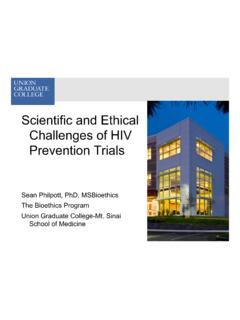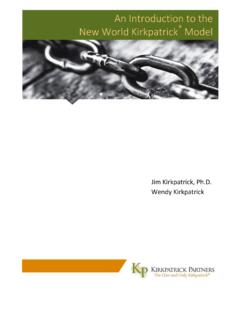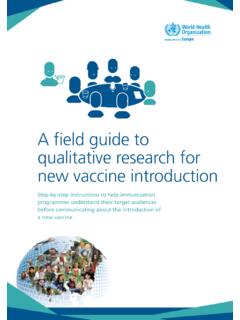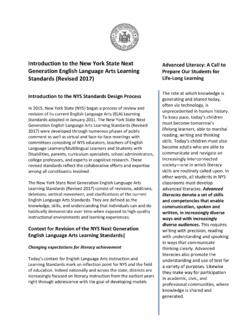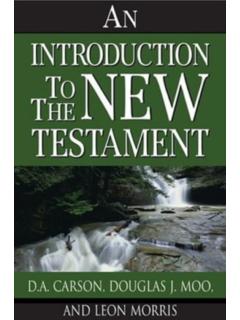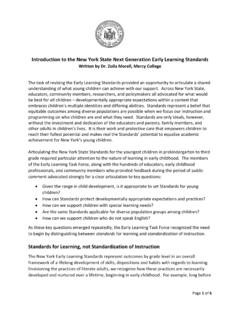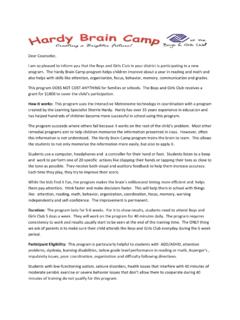Transcription of Introduction to the New Testament - fordham.edu
1 1 Introduction to the New Testament Theo 3200 R21 Tuesday, Wednesday, Thursday 6:00-9:00 LL TBA Professor Lynne Moss Bahr LL TBA Office hours Tuesday 4:30-6:00 and by appointment 646-784-5588 Course description: This course provides an Introduction to the primary historical issues concerning critical investigation of the New Testament . A guiding question is, What do the texts represent to us about the social, political, and theological issues of the first few centuries of the common era? We will also ask some larger questions about the role of faith in the critical study of sacred texts, the authority of scripture, and the ways in which interpreters address the gap between the texts ancient contexts and their own age. To these ends we will read the New Testament texts themselves, along with a textbook and some secondary sources, to provide insight into some of the historical, methodological, and interpretive issues.
2 Course Objectives: The primary aim of this course is to develop proficiency in analyzing ancient religious texts. Students will be asked to evaluate critically the particular rhetorical and literary characteristics of the text and situate the text historically. In addition, we will attend to our own presuppositions regarding the texts and how these influence the task of interpretation. Finally, students will gain familiarity with the New Testament and identify key movements, terms, and issues relevant to early Christianity. Course Expectations: Regular attendance at class sessions is expected, as is regular participation. This is not a lecture course. Each week you will prepare a ONE-page position paper; you will also write a longer exegetical paper. (More on this below.) In addition, students will each do a group presentation on the primary source material and participate in debates.
3 Come to class having completed all the reading, and be prepared with questions and comments. Attendance will be taken at each class, and more than two unexcused absences will negatively affect your grade. If you are going to miss a class, you must notify me in advance, and you are responsible for finding out what you missed. Because we will be reading the texts very closely, you are expected to bring your New Testament to every class, along with any other assigned readings. Not bringing the texts to class will negatively affect your participation grade. Students are expected to actively engage in discussions, both in contributing comments and questions and listening attentively. 2 Course Requirements: Grades will be calculated as follows: Position papers 60 points Exegesis Paper 30 points Presentation 20 points Final Exam 120 points Debate/Participation 20 points 250 points possible Required Books: Please purchase the following books at the bookstore or from an online retailer: Harper Collins Study Bible.
4 New Revised Standard Version. 978-0-06-122840-7 The New Testament : A Historical Introduction to Early Christian Writings, sixth edition, by Bart D. Ehrman. Be SURE to have the SIXTH EDITION. 978-0-19-020382-5 Lost Scriptures: Books that Did Not Make It into the New Testament , by Bart D. Ehrman. 978-0-19518250-7 The Meaning of Jesus: Two Visions, by Marcus J. Borg and Wright. 978-0-06-128554-7 Schedule: Week One 7/5 Introductions, syllabus BACKGROUNDS Ehrman textbook, pp. 1-19, 41-95 7/6 MARK Gospel of Mark Ehrman textbook, pp. 96-119 Position paper: How does Mark stress the need for Jesus, Son of God, to suffer and die? Why do the characters in the Gospel not understand this necessity? Week Two 7/11 MATTHEW Gospel of Matthew Ehrman textbook, pp. 129-148 Group A presentation 7/12 LUKE Gospel of Luke Ehrman textbook, pp.
5 149-168 7/13 JOHN Gospel of John Ehman textbook, pp. 169-194 3 Group B presentation Debate #1 Position paper: What is the significance of Jesus public declarations of his identity and the signs he performs? Debate topic: Argue for or against this statement: The Jesus of John is fundamentally different than the Jesus of the Synoptics. Week 3 7/18 IDENTITY OF JESUS 10/20 Borg and Wright, pp. 3-27, 111-168 10/23 Alternative Images of Jesus Infancy Gospel of Thomas (Lost Scriptures, pp. 57-62) Gospel of Mary (Lost Scriptures, pp. 35-37) Gospel of Thomas (Lost Scriptures, pp. 19-28) 7/19 Acts and Church History Acts of the Apostles Acts of Peter (Lost Scriptures, 135-154) Ehrman textbook, pp. 312-333 7/20 Paul: Church Conflict and Community 1 Thessalonians Ehrman pp.
6 353-367 1 Corinthians Ehrman, pp. 368-379 Group C presentation Position Paper: Referring to either 1 Thessalonians or 1 Corinthians, identify a major conflict in the community and how Paul attempts to resolve it. Week 4 7/25 Paul and the Law Galatians Romans Ehrman, pp. 383-392, 401-414 7/26 Gender in Early Christianity Acts of Thecla (Lost Scriptures, pp. 113-121) 1 Timothy Ephesians Ehrman, pp. 460-473 Group D presentation 4 7/27 Christians and Jews Hebrews Epistle of Barnabas (Lost Scriptures, pp. 219-35) Ehrman, pp. 474-491 Debate #2 Position paper: Reread Romans 1-8. Why do people need to be justified before God, and how does the law figure into justification? Debate topic: Argue for or against this statement: Women had authority in Early Christianity.
7 Week 5 8/1 Christians and Rome 1 Peter Ehrman, pp. 493-504, 529-542 Pliny-Trajan correspondence Group E presentation 8/2 Revelation/Apocalypses Revelation 8/3 Apocalypse of Peter (Lost Scriptures, 280-287) Ehrman, pp. 544-546 Review for final exam Exegesis Paper Due Position paper: Identity the key issues leading to the persecutions of Christians under the Roman Empire. What is the particular nature of the threat to Rome? Final Exam is August 8 at 6:00 Position Papers Submit your position paper on Thursday each week as a HARD COPY. Address the question or issue posed for that week in ONE PAGE. This paper should not consist of your personal reflections or opinions. Take a position and support it with textual evidence from the primary source, not the textbook.
8 Include your name and the date in a header, then use 12-point type, 1-inch margins, and spacing. Use short parenthetical notations for references ( Matt. 4:1-3). Each paper must include a thesis statement of not more than 20 words. Set this off at the top of the page. Use the rest of the paper to develop and defend this thesis. Your paper may not exceed one page. Each paper is worth 15 points. 5 Late position papers are not accepted. Plan enough time for printing that you can resolve a problem before class. You may not e-mail me the position paper. Exegesis Paper Using the interpretive theories and hermeneutical approaches we have studied in class, in addition to any other scholarly resources, write a four- to five-page paper in which you critically analyze a passage from the New Testament or one of the other early Christian texts in this course.
9 First, select a short passage (10-15 lines; 4-5 verses) and then explicate the passage s theological meaning in addition to how it represents (or resists) its sociohistorical setting. You should also analyze how the passage functions in the larger narrative to which it belongs. Your analysis should examine short phrases or individual words, aiming to unpack the full meaning of the passage. Use 1-inch margins, 12-point type, and double spacing. Be sure to properly cite your sources. If you are taking material verbatim from a source, you must enclose the material in quotation marks and cite the source with a footnote. If you are paraphrasing, you must introduce the material as coming from another author and use a footnote to cite the source. Use this website as a resource for your citations: You must include a bibliography.
10 Presentations Each student will be assigned with a group to present the primary source material to the class on a given session. In these presentations you should introduce the reading, provide a brief summary of its contents, identify a passage that is especially compelling or problematic for close reading, and lead the class in a discussion. You may use media such as a short video, Powerpoint, handouts, or other resources to focus the discussion. The presentation should be about 15 minutes, not including the class discussion. Debates Each student will participate in one of the two debates. You will be assigned either pro or con in advance of the debate. Come to class prepared with notes for the debate. For the debate in which you are not a participant, you will be a judge, and decide with the others which group made the better case.









